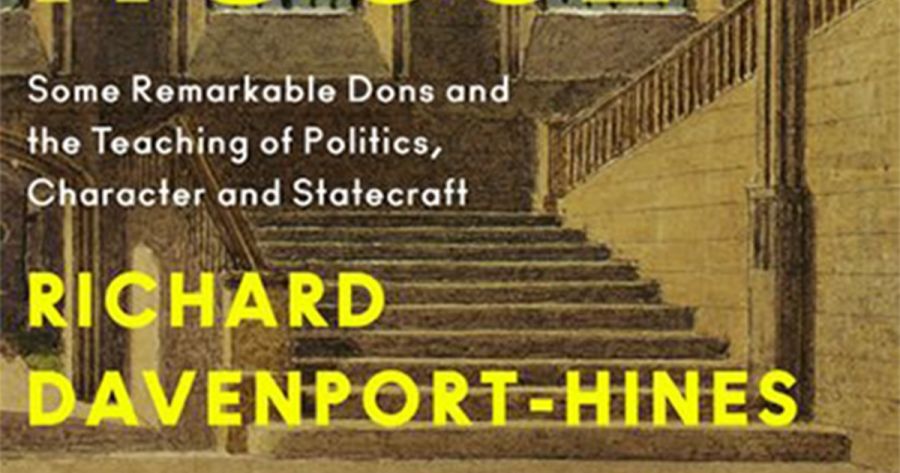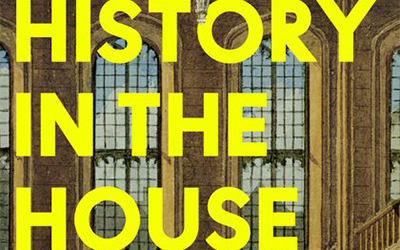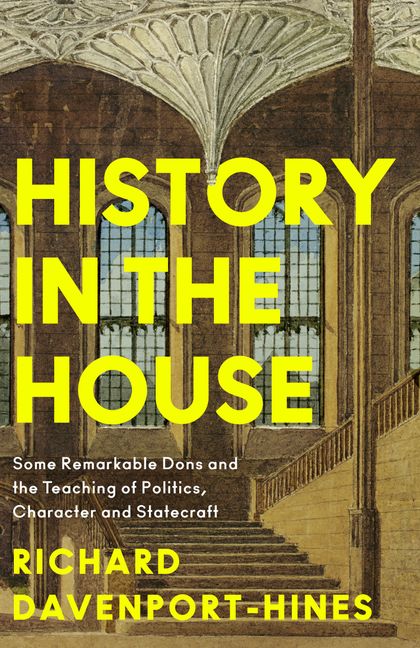
- Free Article: No
- Contents Category: United Kingdom
- Review Article: Yes
- Article Title: ‘History makes us old’
- Article Subtitle: A meditation on a lost world of tradition
- Online Only: No
- Custom Highlight Text:
In Yes, Prime Minister, Sir Humphrey Appleby spells out the really important things in British life: Radio 3, the countryside, the law, and the universities – both of them. It is an amusing reminder that writing on higher education in the United Kingdom focuses on just a handful of institutions. In History in the House, Richard Davenport-Hines takes this approach much further – to just one discipline in a single Oxford college, Christ Church, known as ‘the House’.
- Featured Image (400px * 250px):

- Alt Tag (Featured Image): Glyn Davis reviews 'History in the House: Some remarkable dons and the teaching of politics, character and statecraft' by Richard Davenport-Hines
- Book 1 Title: History in the House
- Book 1 Subtitle: Some remarkable dons and the teaching of politics, character and statecraft
- Book 1 Biblio: William Collins, $29.99 pb, 432 pp
- Book 1 Cover Small (400 x 600):

- Book 1 Cover (800 x 1200):

Amid this distinguished oeuvre, History in the House is unusually narrow. Over more than 400 pages, Davenport-Hines traces how a handful of historians – all male, all based in the House – developed their understanding of historical practice. This might suggest a commissioned work, but the author stresses there was no ‘sponsorship, oversight or approval of any Oxford institution or individual’. Davenport-Hines, trained at Cambridge, formed deep friendships with colleagues at Christ Church, who offered ‘new ways to think, watch and rejoice’. History in the House is his thank you, an exploration of the character and meaning of history.
A superb opening chapter spans the origins of Christ Church amid the foundational role of universities – Oxford is six hundred years older than the United Kingdom. The historian, he suggests, is nurtured by working over long periods with an impressive collection of like-minded colleagues. The remarkable dons of the subtitle study the past to interpret the present. This is the central thesis of the book: the Christ Church tradition is not historical study for its own sake but careful attention to statecraft – the ‘study of how history improved the minds, enlarged the imaginations and broadened the vicarious experiences of princes, noblemen and administrators’. Christ Church has educated a British monarch (Edward VII), thirteen prime ministers, and sundry leaders of other nations, alongside generations of civil servants. The teaching of modern history becomes a vehicle for shaping those who will govern.
This mode of history does not lean to impartiality. ‘History is an interpretation of the past as seen through another’s temperament,’ suggested essayist Charles Whibley. Though shaped by professional norms about evidence and argument, writing history in the Christ Church mode is an intensely personal journey. No wonder E.H. Carr urged his readers to ‘study the historian before they begin to study the facts’.
Davenport-Hines acknowledges the maleness of the House; it was 1980 before a woman graduated from Christ Church, and 2023 before a woman became Dean, after nearly five centuries of continuous appointments to the role. The stories of dons and students, statecraft offered and absorbed, are those of males, including boys (from medieval times, those attending university were often aged between twelve and eighteen, as they trained to serve the state). During the Civil War, the College was sacked by parliamentary troops, who expelled most scholars and students for loyalty to Charles I. It proved a short interruption amid centuries of fealty to the British monarchy. The philosopher John Locke was ousted for preferring a pretender to the throne, while Catholics were barred for two hundred years because Anglicanism was the accepted orthodoxy. Young noblemen enrolled in the College added a gold tassel to their trencher to signify rank. Until 1862, students drawn from the nobility had designated seats at high table. Christ Church being also a cathedral, here was the British state at prayer and study.
Yet Davenport-Hines is keen to stress innovation within this apparently settled institutional role. Edward Nares, educated at Christ Church and later the Regius Professor of Modern History, worried about the undergraduates who passed their university years ‘idle, ignorant and dissipated’. Oxford introduced exams to test student learning, and from 1809 divided degrees into first, second, and third classes. New subjects were introduced alongside the Literae Humaniores, the classics curriculum, including mathematics and physics.
This is the setting for Davenport-Hines’s chief interest: the individual scholars of Christ Church and the idea of history they embraced. This begins with rejection of ‘mere’ chroniclers in favour of history as an art of thought, bringing a critical spirit to the materials interrogated. To provide lessons in statecraft, history must be empirical, ‘a form of knowledge that deductive minds might apply in practice’. In the words of Thomas Fuller, who wrote the first history of the Crusades in English, ‘history makes a young man to be old’, privileging him with wisdom without the inconvenience of acquiring experience.
Hence the latter half of the book is devoted to essays on a small number of Christ Church dons, beginning with Frederick York Powell. There are traditionalists and reformers, brilliant lecturers and those given to rambling. Generations of teachers and their students walk through Davenport-Hines’s narrative of history at Christ Church. The detail can be daunting – but just as the historian Edward Armstrong taught his pupils to frame their writing from ‘trifling incidents, the straws and feathers of history’, so Davenport-Hines is a skilled writer, confident the picturesque will hold attention as he sketches the broader theme.
There are high points for the College, such as Keith Feiling teaching an extraordinary array of politicians and administrators from 1911, with an influence through the Conservative Party that was felt for decades. Among his skills was recommending students who ‘excelled at sports rather than brainwork’ to rule outposts of the British Empire. The undergraduate study of history at Christ Church reached its apogee in the 1920s, before courses in Politics, Philosophy and Economics began drawing away many talented students during the Great Depression.
Yet nearly a century of history, in both senses, awaits in later chapters. Memorable figures follow, including the masterful historian J.C. Masterman, who combined scholarship with wartime duties as a spy. Hugh Trevor-Roper also proves a champion for his college. ‘Modern History,’ he argued in 1952, ‘is replacing the ancient classics as the intellectual training of our century.’ Books such as The Last Days of Hitler and combative television appearances would make Trevor-Roper a public intellectual in Britain and beyond. The account by Davenport-Hines touches on numerous academic controversies, though not the Hitler diaries scandal of 1983. By then Trevor-Roper, recently ennobled by Margaret Thatcher, had left Oxford to become Master of Peterhouse College at Cambridge.
And so through to Robert Blake, historian of the Conservative Party and biographer of Benjamin Disraeli, made a life peer by Edward Heath. Davenport-Hines’s story begins to end here, sometime late in the twentieth century. History as a training in statecraft seems no longer credible in a diminished Britain. History in the House closes with a trenchant list of proximate causes. Academic specialisation narrowed the aims of imagination, while young scholars were attracted to the ‘schematizing yet destructive ideas of Michel Foucault’. Cultural leadership passed from universities, while government direction turned university administration into something resembling ‘the managerialism of nationalized industries’. On this lesser world, concludes Davenport-Hines, shades of the past historians of Christ Church, students and scholars alike, ‘watch agape’.
It is a bleak close to an unusual work, a meditation on a lost world of tradition and custom, a place where original thinking was nurtured within a deeply established institution. Davenport-Hines does not ask whether contemporary understandings of democracy and equality are incompatible with the House ethos recalled so lovingly in these pages. But then melancholy at time past might be the most fitting memorial.


Comments powered by CComment